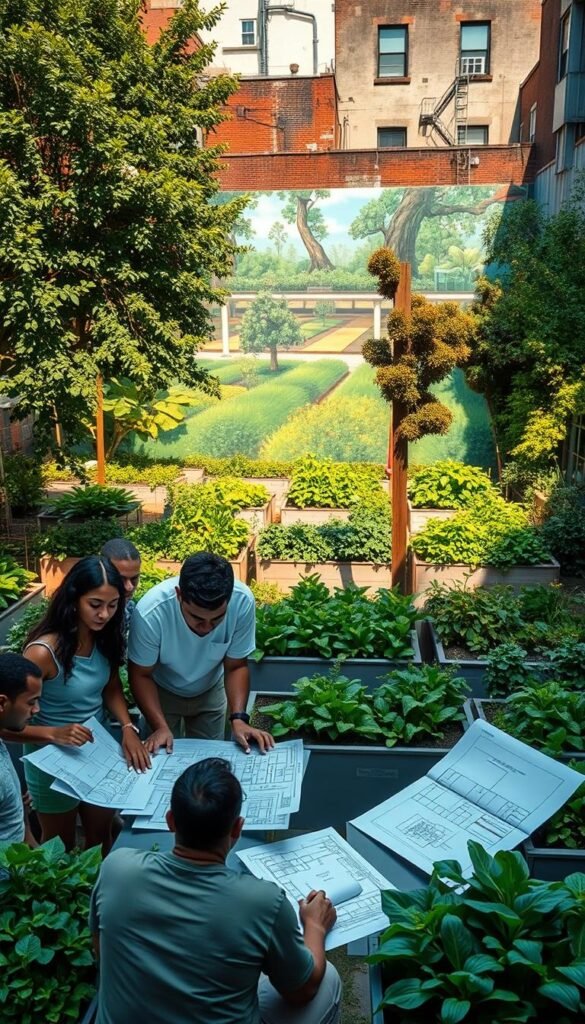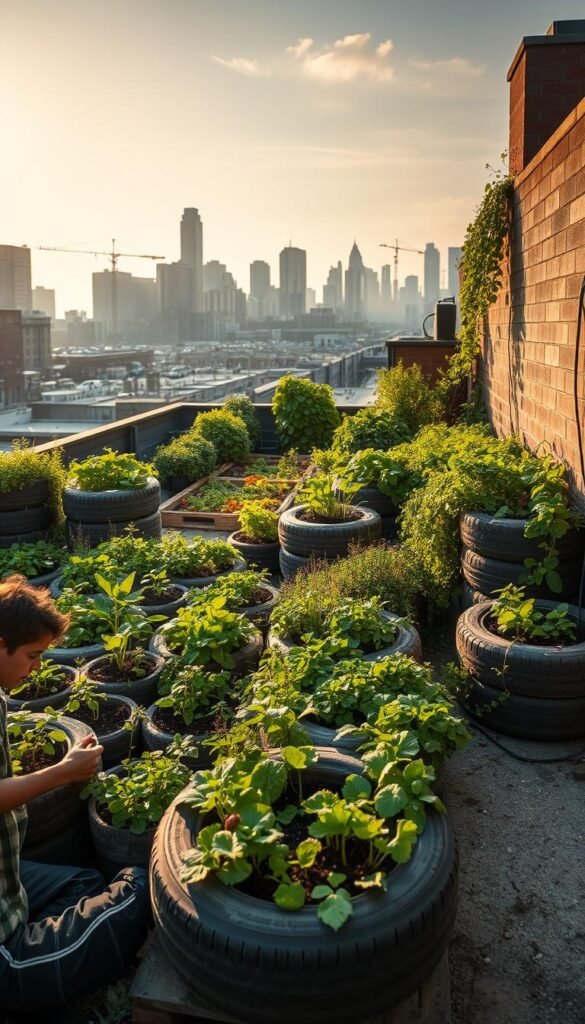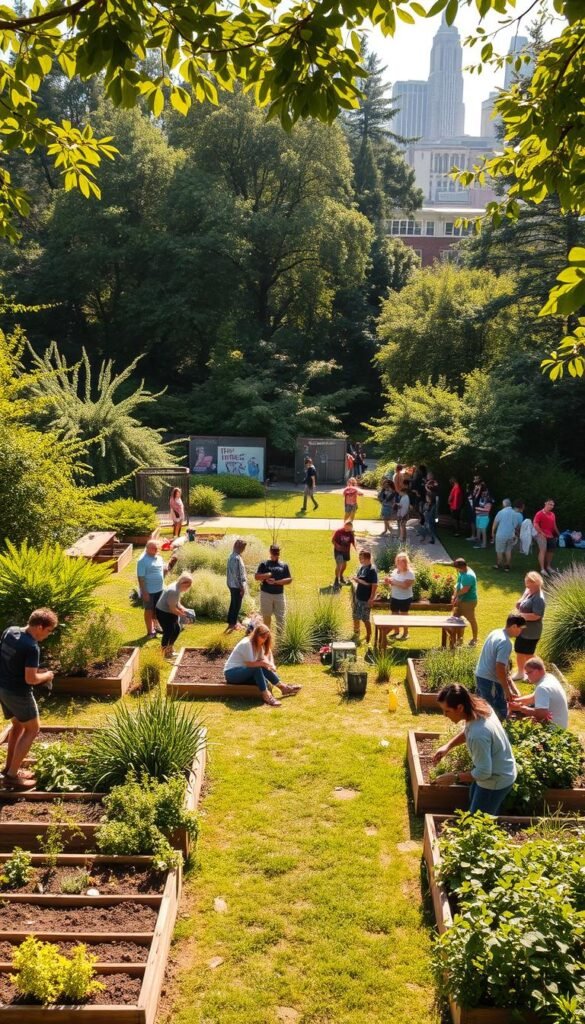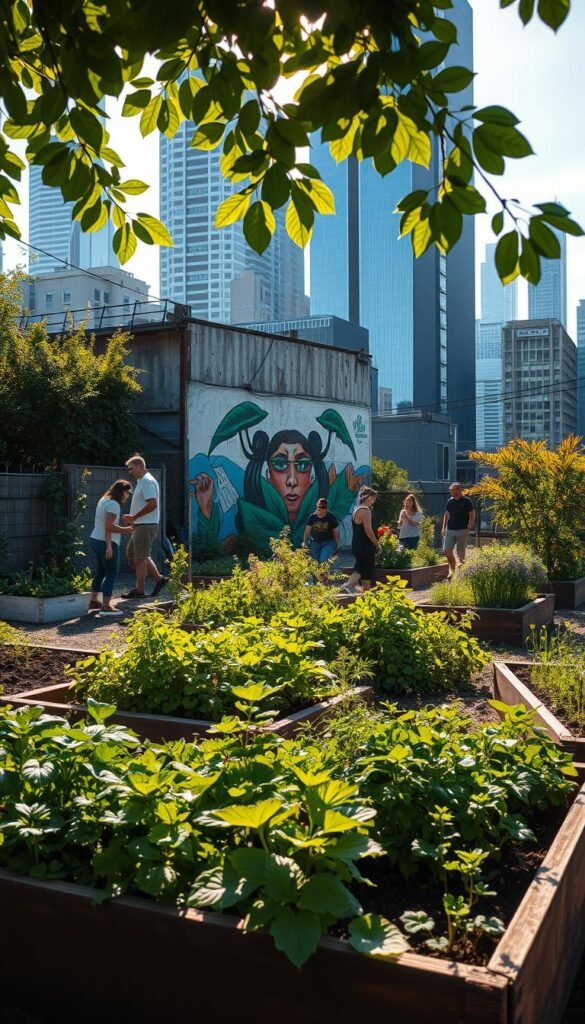Imagine walking past a cracked parking lot littered with trash—only to find it bursting with sunflowers weeks later. This is the magic of urban transformation through grassroots action. Across the U.S., people are turning neglected corners of their neighborhoods into thriving green spaces, one seed at a time.
This movement blends creativity with purpose. Activists like Richard Reynolds and Ellen Miles pioneered the idea of reclaiming unused land for public beauty and environmental health. Their work proves you don’t need permission to make a difference—just passion, some soil, and a handful of resilient plants.
Why does this matter? Overgrown lots harm communities by attracting pests and lowering property values. But when locals collaborate to plant native flowers or vegetables, they create safer, healthier areas. These projects spark pride and connection, showing how small acts grow into lasting change.
Ready to dig deeper? You’ll discover how art, ecology, and neighborhood bonds come together in this vibrant practice. Let’s explore how ordinary people are reshaping cities—one hidden garden at a time.
Understanding Guerrilla Gardening & Its Urban Impact

Picture a vacant lot transformed into a vibrant garden overnight. This spontaneous act of green rebellion defines guerrilla gardening—a practice where ordinary people revitalize neglected spaces through unauthorized planting. It’s equal parts environmental activism and creative placemaking.
What Is Guerrilla Gardening?
At its core, it’s about reclaiming land for public good. Participants might scatter seed bombs in cracked sidewalks or plant flowers under cover of darkness. The goal? To turn eyesores into habitats while challenging ideas about urban ownership.
Historical Roots and Evolution
The movement sprouted in 1970s New York when artist Liz Christy turned a rubble-filled lot into a community garden. By the 2000s, London activists like Richard Reynolds popularized nighttime “gardening flash mobs.” Today, it’s evolved into global networks restoring biodiversity in concrete-heavy areas.
Social and Environmental Benefits
These green interventions reduce urban heat and filter polluted air. They also strengthen neighborhoods—a study in Detroit showed community-managed spaces lowered crime rates by 13%. When you nurture plants together, you grow connections too.
From dandelions pushing through pavement to sunflower clusters brightening train tracks, these acts prove nature thrives where we least expect it. All it takes is soil, seeds, and shared vision.
Guerrilla Gardening: Bringing Life to Abandoned City Lots

What if a forgotten alley could become a butterfly sanctuary in weeks? Across U.S. cities, grassroots efforts are proving it’s possible. Volunteers swap weeds for wildflowers and cracked pavement for kale patches—all without official permits.
Reviving Neglected Urban Spaces
Take Detroit’s “Seed Justice” project. A group transformed a trash-filled parking area into a pollinator garden using native milkweed and coneflowers. “We chose plants that thrive on neglect,” says organizer Clara Boyd. “Now it’s a pit stop for monarchs migrating through the city.”
Real-World Success Stories
In Philadelphia, neighbors secretly planted apple trees along a barren lot. Three years later, it’s a shaded gathering spot with free snacks for passersby. “People protect what they help create,” notes activist Ellen Miles. Her team’s midnight sunflower project in Brooklyn lowered street temperatures by 4°F during heatwaves.
Key strategies making these wins possible:
- Seed bombing: Clay-wrapped wildflower mixes tossed into hard-to-reach areas
- Edible landscaping: Berry bushes replacing chain-link fences
- Night ops: Quick planting sessions under moonlight
These stories show how scrappy efforts grow into lasting change. You might spot tomato vines climbing subway stairs or herbs sprouting from old tires—proof that even tiny green acts reshape neighborhoods.
Planning Your Guerrilla Gardening Project

Ever spotted a weedy lot and imagined it bursting with color? Successful green transformations start with smart preparation. Let’s map out your path from idea to blooming reality.
Assessing and Choosing Your Site
Start by scouting locations during different times of day. Look for spots with at least 4 hours of sunlight and decent soil. Avoid areas with heavy foot traffic or chemical residues. Pro tip: Test drainage by pouring a cup of water—if it disappears in 10 minutes, you’re golden.
Prioritize native plants like coneflowers or sage—they thrive with minimal care. “Choose species that match your site’s conditions,” advises Portland-based organizer Maya Torres. “It’s not about what’s pretty—it’s about what works.”
Community Outreach and Collaboration
Knock on doors near your chosen site. Share your vision over flyers or social media posts. One Baltimore group gained support by hosting a “seed swap” picnic at a nearby park. Remember: Involved neighbors become protectors.
“We framed it as a gift, not a takeover. Now residents water the roses themselves.”
Reach out to local nurseries for donations—many offer discounts for community projects. Partner with schools or churches to organize planting days. These connections help your garden survive and evolve.
Tactical Approaches: Daytime and Nighttime Gardening

Think of transforming a forgotten sidewalk crack into a floral surprise. Timing matters as much as technique when cultivating unexpected green spaces. Whether you’re planting openly or stealthily, strategic choices determine your garden’s success.
Covert Tactics and Legal Considerations
Night operations offer privacy but require quick moves. Use moonlit hours for low-visibility planting in high-traffic areas. Seed bombs—clay-packed wildflower mixes—let you “decorate” hard-to-reach spots discreetly. Always research local land-use laws first. As urban greening expert Lisa Sanchez advises: “Know your boundaries. Some cities classify unauthorized planting as trespassing, while others celebrate it.”
Selecting the Right Plants for Low Maintenance
Choose species that thrive with minimal care. Drought-resistant natives like yarrow or lavender survive tough urban conditions. Fast-growing annuals like cosmos add quick color without demanding attention. See how popular options compare:
| Plant Type | Water Needs | Growth Speed | Best For |
|---|---|---|---|
| Sunflowers | Low | Fast | Daytime visibility |
| Sedum | Very Low | Slow | Stealth ground cover |
| Milkweed | Moderate | Medium | Pollinator support |
Tools, Techniques, and Timing
Pack light for nighttime missions—a trowel, gloves, and seed packets fit in a backpack. Daytime projects allow larger tools but attract more eyes. Water-efficient methods like olla pots (buried clay vessels) reduce return visits. Pro tip: Plant during cool morning or evening hours to help seedlings beat the heat.
“The sweet spot? Playful rebellion paired with smart planning. Your energy should go into growing, not explaining.”
Transforming Neglected Spaces into Community Havens

What happens when neighbors unite to reimagine a dusty corner? Vibrant community hubs emerge, blending greenery with local culture. These projects thrive when partnerships meet creativity—and you can lead the charge.
Building Local Partnerships
Start by connecting with schools, cafes, or artists’ collectives. In Cleveland, a muralist teamed with residents to turn a vacant area into a storytelling garden. “We painted benches with native flowers,” says organizer Tina Rowe. “Now families gather there weekly.”
Key partnership wins:
- Local nurseries donating seeds and soil
- Artists designing interactive plant markers
- Teens building compost stations from reclaimed wood
Integrating Artistic and Green Elements
Mix practicality with wonder. A Chicago group installed rain-catching sculptures that double as trellises for climbing vines. Use native grasses to frame colorful mosaics—or let wild nature contrast with geometric murals.
| Art Element | Plant Pairing | Community Impact |
|---|---|---|
| Painted murals | Climbing ivy | Boosts neighborhood pride |
| Recycled sculptures | Drought-tolerant sage | Encourages eco-awareness |
| Mosaic pathways | Creeping thyme | Invites foot traffic |
These spaces become more than gardens—they’re living landmarks. As you plan, explore community garden benefits to inspire your vision. Your transformed space could host poetry nights, birdwatching clubs, or harvest festivals. Ready to paint the city green?
Cultivating Your Future in Guerrilla Gardening
Envision a future where cracked sidewalks bloom with milkweed and empty lots hum with pollinators. Your hands can make this real. Across urban spaces, everyday people are rewriting what’s possible—turning neglected corners into thriving ecosystems that outlast seasons.
This practice has grown beyond secret seed bombs. Today, it’s about creative collaboration. Like the Phoenix group painting rain barrels beside their tomato vines, or Detroit teens building butterfly habitats. Your project could blend murals with marigolds, or poetry readings with pea patches.
Start small but think big. Choose plants that feed both soil and soul—native flowers for bees, berry bushes for neighbors. Share extra seeds at local cafes. Every sunflower that pushes through concrete shouts: “This space matters.”
Your work joins a legacy. From 1970s New York to today’s rooftop farms, gardeners prove change grows where care takes root. What story will your community tell about the lot you transformed? Grab a trowel, rally friends, and let the earth speak through you.






